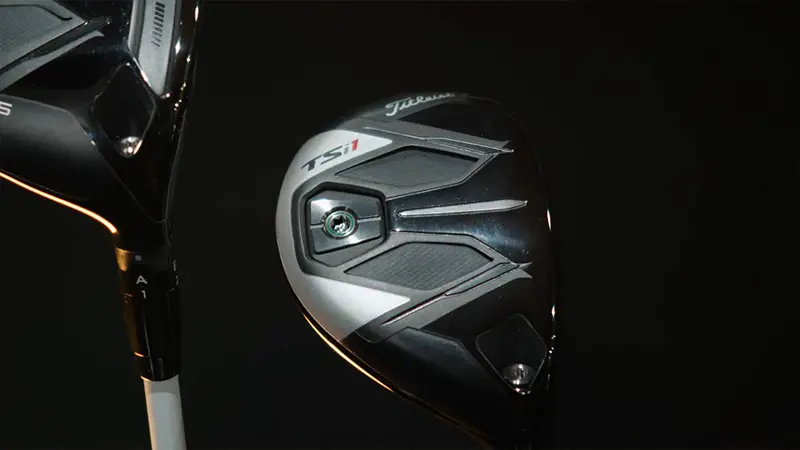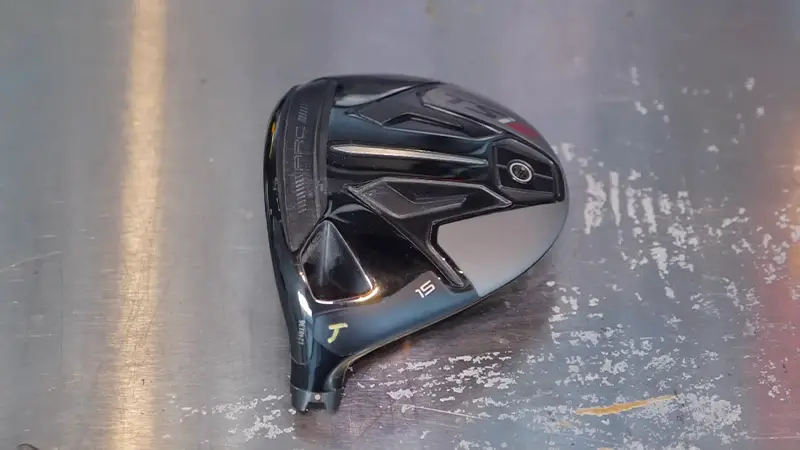Titleist, a trailblazer in golf innovation, has harnessed the power of carbon fiber to redefine the performance landscape of its woods. This cutting-edge material, renowned for its lightweight strength and adaptability, has become a cornerstone of Titleist’s commitment to pushing the boundaries of golf club design.
By seamlessly integrating carbon fiber into their woods, Titleist has unlocked a realm of possibilities aimed at enhancing a golfer’s experience on the course.
This introduction delves into the pivotal reasons behind Titleist’s strategic embrace of carbon fiber, highlighting how it revolutionizes club dynamics, offers unmatched customization, and solidifies Titleist’s reputation as a paragon of technological advancement in the golfing realm.

The History of Titleist
Founded in 1932, Titleist has grown to embody golfing excellence. From its origin as a golf ball producer by Philip E. Young, the brand swiftly ascended, celebrated for superior quality and innovation. By the 1960s, Titleist ventured into clubs, further solidifying its influence.
Acquired by Acushnet in 1976, Titleist continued to flourish, with its Pro V1 ball transforming the industry in 2000. Renowned for its global presence, Titleist equipment has propelled numerous professionals to victory.
Beyond success, the brand actively engages with communities, supporting growth and fostering grassroots connections. Titleist’s journey is one of unwavering commitment to crafting superior golfing experiences.
Why Does Titleist Use Carbon Fiber in Woods?
Titleist, a renowned name in the golf industry, has embraced carbon fiber as a crucial material in the construction of their woods for several compelling reasons.
Carbon fiber, a lightweight and high-strength composite material, offers unique advantages that align with the demands of modern golfers and the ever-evolving golfing landscape.
The decision to incorporate carbon fiber into their woods reflects Titleist’s commitment to pushing the boundaries of technology and performance.
Here are the primary reasons why Titleist employ carbon fiber in their woods:
Weight Optimization
Carbon fiber’s exceptional strength-to-weight ratio allows manufacturers like Titleist to create golf club components that are both strong and light.
By using carbon fiber in key areas of the clubhead and shaft, the overall weight of the wood can be strategically distributed.
This optimization of weight distribution contributes to improved clubhead speed, greater control, and enhanced distance.
Enhanced Feel and Feedback
Carbon fiber’s properties can be finely tuned to dampen unwanted vibrations while transmitting crucial feedback to the golfer’s hands.
This allows players to sense the impact of their shots more acutely, aiding them in making adjustments to their swing and achieving consistent results.
Customizable Flex and Rigidity
Carbon fiber’s versatility enables designers to fine-tune the flex and rigidity of specific sections of the club, such as the shaft.
This customization offers golfers the opportunity to select a club that matches their swing style and maximizes their performance. Players can choose between different shaft options to optimize launch conditions and shot dispersion.
Aerodynamics and Performance
Carbon fiber’s strength allows for innovative designs that improve aerodynamics. By strategically placing carbon fiber elements within the clubhead, designers can streamline the shape, reduce drag, and enhance the overall efficiency of the club’s swing through the air. This can lead to increased clubhead speed and, consequently, greater ball velocity.
Consistency and Durability
Carbon fiber’s inherent stability ensures consistent performance over time. Unlike some other materials, carbon fiber retains its structural integrity and properties even under various weather conditions and repeated use.
This durability translates into longer-lasting clubs that maintain their performance characteristics.
Design Flexibility
Carbon fiber’s molding capabilities enable intricate and precise designs that might not be achievable with other materials.
This flexibility allows designers to optimize weight distribution and fine-tune the center of gravity (CG) to improve launch conditions, forgiveness, and shot shaping.
Visual Appeal
Carbon fiber’s distinctive weave pattern and modern aesthetic appeal contribute to the visual allure of Titleist woods.
The unique look of carbon fiber creates a sense of prestige and sophistication that resonates with golfers who appreciate both performance and aesthetics.
Vibration Dampening and Sound Control
Carbon fiber’s unique properties allow engineers to design clubs with improved vibration dampening and sound control.
Unwanted vibrations and harsh sounds upon impact can be minimized, providing a more satisfying and comfortable feel to the golfer. This not only enhances the overall playing experience but also provides valuable feedback for swing adjustments.
Weight Redistribution for Forgiveness
Carbon fiber’s versatility enables engineers to strategically redistribute weight within the clubhead. This redistribution can lead to a higher moment of inertia (MOI), resulting in greater forgiveness on off-center hits.
Golfers can enjoy more consistent performance even when they don’t strike the ball perfectly in the center of the clubface.
Technological Prestige
The use of carbon fiber in Titleist Woods represents the incorporation of cutting-edge technology in golf equipment. Golfers are drawn to brands that embrace innovation and continually strive to push the limits of performance.
By utilizing carbon fiber, Titleist reinforces its reputation as a leader in technological advancements within the golf industry, attracting players who seek the latest and most effective tools for their game.
What Makes Carbon Fiber Strong

Carbon fiber’s exceptional strength stems from its unique molecular structure and manufacturing process.
Here’s what makes carbon fiber a strong and robust material:
High-Tensile Strength
Carbon fiber is composed of tightly packed carbon atoms arranged in a crystalline structure. This arrangement gives it high tensile strength, meaning it can withstand significant pulling or stretching forces without breaking.
The carbon-carbon bonds in the structure are incredibly strong, making carbon fiber inherently resilient.
Low Weight and High Strength
One of carbon fiber’s most notable features is its low weight coupled with remarkable strength-to-weight ratio.
The material is incredibly lightweight compared to its strength, which makes it ideal for applications where weight savings are crucial without compromising on strength and durability.
Alignment of Fibers
During the manufacturing process, carbon fiber strands (or “tows”) are carefully aligned in a specific direction and then bonded together with a matrix material, often epoxy resin.
This alignment of fibers along the direction of the load helps optimize the material’s strength and stiffness in the desired direction.
Resistant to Chemicals and Corrosion
Carbon fiber is inherently resistant to many chemicals and corrosive agents. This property ensures its longevity and structural integrity in various environments, including those with exposure to moisture, saltwater, and acidic substances.
Excellent Fatigue Resistance
Carbon fiber exhibits excellent fatigue resistance, which means it can endure repeated loading and unloading cycles without suffering from structural degradation. This property is crucial for applications where materials are subjected to cyclic stress over time.
Customizability
Carbon fiber’s strength can be tailored based on the number of layers, fiber orientations, and the type of resin used during the manufacturing process. This allows engineers to create components with specific strength characteristics that suit the intended application.
Composite Structure
Carbon fiber is often used as part of a composite structure where it’s combined with a matrix material (such as epoxy) to create a composite material.
This combination maximizes the strengths of both materials, resulting in a synergistic effect that enhances overall strength and performance.
Rigidity and Stiffness
In addition to strength, carbon fiber also offers high rigidity and stiffness. This makes it an excellent choice for applications where maintaining shape and resisting deformation under load are crucial factors.
Pros and Cons of Titleist’s Carbon Fiber Woods

Pros of Titleist’s Carbon Fiber Woods:
Enhanced Performance
Carbon fiber construction allows for precise weight distribution, optimizing the center of gravity and leading to improved clubhead speed, ball speed, and distance.
Customizable Flex
Carbon fiber’s versatility enables the design of shafts with specific flex profiles, catering to individual swing styles and maximizing launch conditions.
Vibration Dampening
Carbon fiber’s properties can dampen unwanted vibrations, enhancing the feel and feedback upon impact, leading to better control and shot-making.
Lightweight Strength
Carbon fiber’s high strength-to-weight ratio contributes to lighter clubheads, which can translate to faster swings and increased forgiveness on off-center hits.
Durability
Carbon fiber’s resilience ensures that Titleist woods maintain their performance characteristics over time, even with repeated use and exposure to various playing conditions.
Cons of Titleist’s Carbon Fiber Woods:
Cost
Carbon fiber manufacturing processes can be complex and expensive, which might reflect in the price of Titleist’s carbon fiber-equipped woods.
Feel Preference
While many golfers appreciate the dampened vibrations, some players might prefer a different feel or feedback upon impact, which can be subjective.
Adjustment Period
Golfers transitioning to carbon fiber-equipped woods might require an adjustment period to adapt to the different feel and performance characteristics.
Visual Appearance
While carbon fiber’s weave pattern can be visually appealing to many, some golfers might have aesthetic preferences that don’t align with this modern look.
Specificity of Benefits
Some players might not fully capitalize on the benefits of carbon fiber if their swing style or playing level doesn’t align with the nuances of the material’s properties.
FAQS
Does carbon fiber affect the overall durability of Titleist woods?
Yes, carbon fiber’s durability enhances the longevity of Titleist woods.
How does carbon fiber impact the club’s balance and stability?
Carbon fiber’s weight optimization allows for precise weight distribution, enhancing the club’s balance and stability during the swing.
Is there a noticeable difference in ball flight and trajectory due to carbon fiber usage?
Carbon fiber’s design flexibility enables engineers to fine-tune the center of gravity and launch conditions.
Can amateur golfers benefit from carbon fiber-equipped Titleist woods?
Absolutely, amateur golfers can benefit from the enhanced performance that carbon fiber offers.
Are there any environmental considerations with the use of carbon fiber in woods?
Carbon fiber’s sustainable production methods and potential for recycling align with environmental consciousness.
To Recap
Titleist’s judicious integration of carbon fiber into their woods embodies a commitment to excellence that transcends tradition. The marriage of this advanced material with Titleist’s storied craftsmanship has yielded clubs that redefine performance metrics.
Carbon fiber’s agility in weight distribution, vibration damping, and personalized flex profiles empowers golfers to elevate their game.
By harnessing this technological prowess, Titleist reiterates its unwavering dedication to enhancing players’ experiences, enabling longer drives, more precise shots, and unmatched feel.
As the golf landscape evolves, Titleist stands as a beacon of innovation, propelling both professionals and enthusiasts toward new heights through the fusion of carbon fiber and golfing artistry.

Leave a Reply